Butterflies are truly magnificent creatures, and Oregon is no exception when it comes to housing a diverse and beautiful butterfly population; there are about 150 existing Oregon butterflies, but we will learn about 22 Common Oregon butterflies in this guide.
Oregon is a paradise for butterfly enthusiasts, boasting different kinds of butterfly species, from Monarch, Painted Lady, Mourning Cloak, Red Admiral, and Western Tiger Swallowtail, each with its own distinctive identifying features.
If you’re eager to explore the vibrant world of Oregon butterflies and learn how to identify them, join me and let us get started!
Also See Missouri Butterflies: Classification And Identification With Pictures
Identifying Features: The Key to Oregon Butterfly Recognition
Colors, shapes, and sizes are distinctive characteristics that aid in identifying the 22 common Oregon butterflies, By understanding these features, we can further appreciate Oregon’s diverse array of butterflies.
Additionally, paying close attention to wing patterns and markings is essential for accurate identification.
Let’s explore some common Oregon butterflies with attractive wing patterns, unique butterflies with unusual features, delicate butterflies with subtle beauty, and those that blend seamlessly into their surroundings.
- Common Butterflies with Attractive Wing Patterns
• Monarch Butterfly (Danaus plexippus)
• Painted Lady Butterfly (Vanessa cardui)
• Mourning Cloak Butterfly (Nymphalis antiopa)
• Red Admiral Butterfly (Vanessa atalanta)
• Western Tiger Swallowtail Butterfly (Papilio rutulus)
#1 Monarch Butterfly (Danaus plexippus)
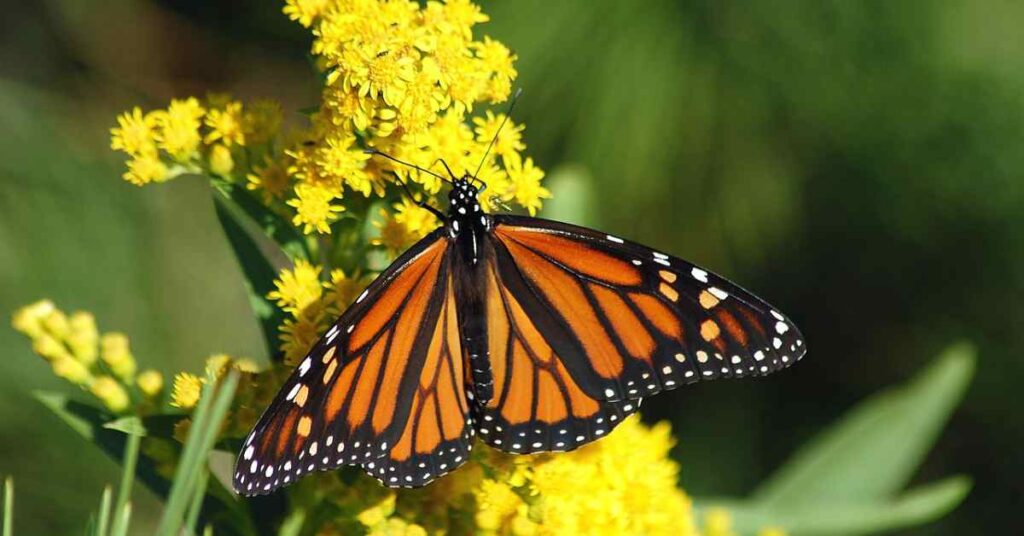
The Monarch Butterfly (Danaus plexippus) is a majestic species found in Oregon.
Size: The Monarch Butterfly boasts an impressive size, with a wingspan measuring 3.5 to 4 inches.
Coloration and Wing Patterns: The Monarch Butterfly exhibits a striking coloration and wing pattern.
The wings are vibrant orange with black veins and borders. The black borders are adorned with white spots and a distinct black-and-white pattern along the outer edges.
The undersides of the wings are similar in coloration but with a muted tone and less defined patterns.
Identifying Features: Identifying the Monarch Butterfly is relatively straightforward due to its unique features.
Its large size, bright orange wings with black borders and veins, and the characteristic black and white pattern on the outer edges make it easily recognizable.
Unique Behaviors: One of the most notable behaviors of the Monarch Butterfly is its incredible long-distance migration.
Each year, Monarchs in Oregon embark on a journey spanning thousands of miles to reach their overwintering sites in Mexico or California. This migration is a remarkable phenomenon in the insect world.
Additionally, Monarch Butterflies engage in a behavior called “puddling,” where they gather in large groups to sip moisture and extract essential nutrients from damp soil or puddles.
This behavior is especially important for the adult butterflies as they require these nutrients for reproduction and energy.
#2. Painted Lady Butterfly (Vanessa cardui)
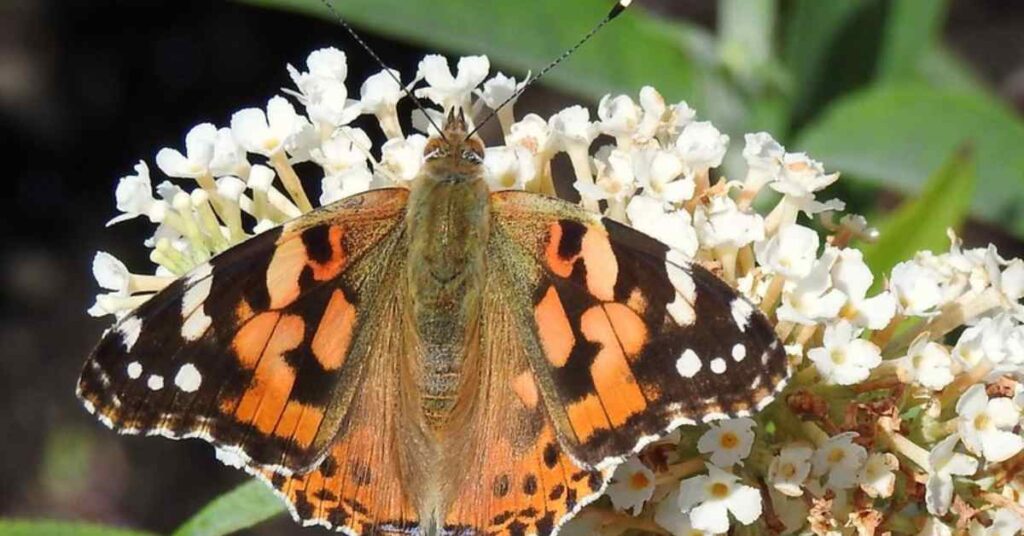
The Painted Lady Butterfly (Vanessa cardui) is a common and captivating species found in Oregon.
Size: It is moderate, with a wingspan measuring around 2.5 to 3 inches.
Coloration and Wing Patterns: The butterfly displays a beautiful coloration and wing pattern.
The wings are primarily orange-brown with black and white markings. The upper side of the wings showcases intricate patterns and a row of eyespots near the wing edges.
Identifying Features: Identifying features of the Painted Lady Butterfly include its size, orange-brown coloration, and distinctive eyespots on the wings.
These eyespots serve as a form of protection against predators.
Unique Behaviors: Unique behaviors of this butterfly include its migratory nature, traveling long distances across different regions, and its ability to utilize a wide range of host plants for egg-laying and caterpillar development.
The Painted Lady Butterfly adds a delightful touch of beauty to the natural landscapes of Oregon.
#3. Mourning Cloak Butterfly (Nymphalis antiopa)

The Mourning Cloak Butterfly (Nymphalis antiopa) can be found in Oregon, showcasing its distinctive characteristics.
Size: It is notable, with a wingspan measuring around 3.5 to 4 inches.
Coloration and Wing Patterns: The butterfly exhibits a unique coloration and wing pattern.
Its wings are primarily dark brown, almost black, with a vibrant yellow border and a row of pale blue spots along the edges.
Identifying Features: The features of the Mourning Cloak Butterfly include its large size, dark brown wings with a yellow border, and a row of pale blue spots.
Unique Behaviors: One of its unique behaviors is hibernation. These butterflies are known to overwinter as adults, seeking shelter in tree crevices or other protected locations.
This remarkable adaptation sets them apart from many other butterfly species, as they emerge early in the spring to begin their life cycle.
#4. Red Admiral Butterfly (Vanessa Atalanta)
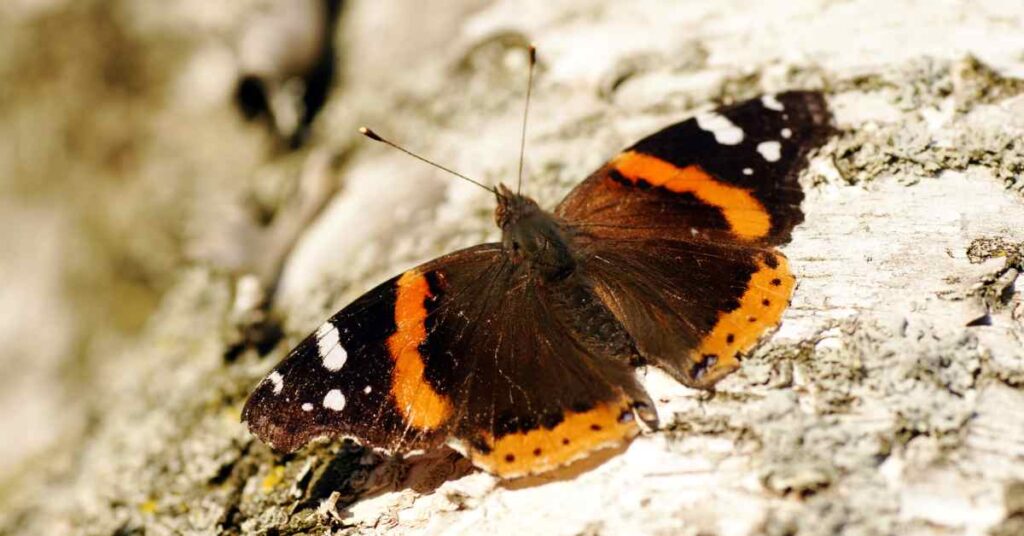
The Red Admiral Butterfly (Vanessa atalanta) is a captivating species found in Oregon.
Size: It is moderate, with a wingspan measuring around 2.5 to 3 inches.
Coloration and Wing Patterns: The butterfly displays a striking coloration and wing pattern.
The wings are primarily black with red-orange bands and white spots. The upper side of the wings features bold red-orange bands and white spots near the tips, while the underside is predominantly mottled brown and grey.
Identifying Features: Identifying features of the Red Admiral Butterfly include its size, black wings with red-orange bands and white spots, and the mottled underside.
Unique Behaviors: A distinctive behavior of this butterfly is its migratory nature, with individuals traveling long distances across different regions.
They are also known to gather in groups to feed on fermenting fruits or other sources of nutrients.
#5. Western Tiger Swallowtail Butterfly (Papilio rutulus)
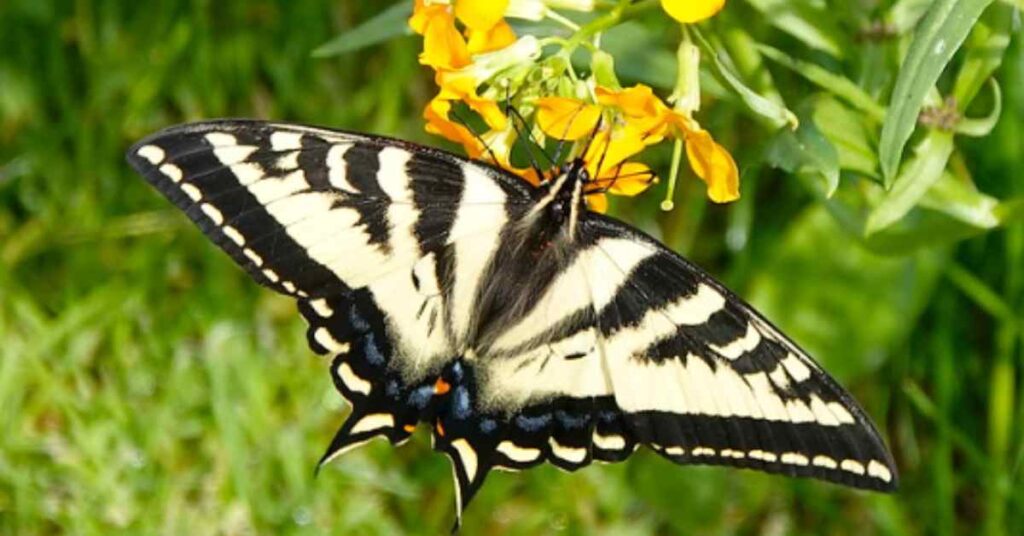
The Western Tiger Swallowtail Butterfly (Papilio rutulus) is a magnificent species found in Oregon.
Size: It boasts a substantial size, with a wingspan measuring 3.5 to 4.5 inches.
Coloration and Wing Patterns: The butterfly displays a captivating coloration and wing pattern.
The wings are predominantly yellow with black stripes and blue markings near the edges.
The upper side of the wings showcases a bold pattern with contrasting colors. At the same time, the underside is paler with muted markings.
Identifying Features: The Western Tiger Swallowtail Butterfly features include its large size, yellow wings with black stripes and blue markings, and distinctive tails on its hindwings.
Unique Behaviors: This species is known for its graceful flight and preference for nectar-rich flowers.
The Western Tiger Swallowtail Butterfly adds a touch of splendor to the Oregon landscape with its vibrant colors and elegant presence.
- Unique Butterflies with Unusual Features
• Oregon Swallowtail Butterfly (Papilio oregonius)
• Anise Swallowtail Butterfly (Papilio zelicaon)
• Lorquin’s Admiral Butterfly (Limenitis lorquinii)
• Acmon Blue Butterfly (Plebejus acmon)
• Sara Orangetip Butterfly (Anthocharis sara)
#6. Oregon Swallowtail Butterfly (Papilio oregonius)
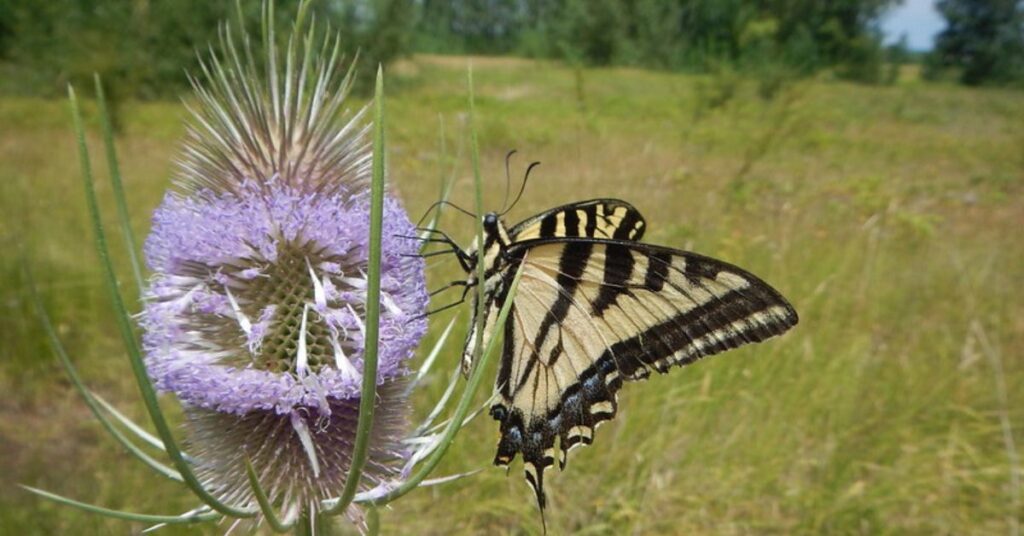
Size: The Oregon Swallowtail has a wingspan of 2.5 to 4 inches.
Coloration and Wing Patterns: The wings are bright yellow with black lines and spots. There is a reddish-orange eyespot along the lower border of the hindwing.
Identifying Features:The Oregon Swallowtail is easily identified by its bright yellow wings with black markings.
The reddish-orange eyespot on the hindwing is also a distinctive feature.
Unique Behaviors:The Oregon Swallowtail has a few unique behaviors. One is that it will sometimes sacrifice its tail to escape predators.
The hope is that the predator will swallow the tail instead of a more critical body part.
The Oregon Swallowtail also has a habit of clustering together on flowers, which can make them easy to spot.
Here are some additional facts about the Oregon Swallowtail Butterfly:
- It is the state insect of Oregon.
- It is a migratory butterfly, and can be found in Oregon from April to September.
- Its caterpillars feed on tarragon sagebrush, which is a type of wildflower.
- The Oregon Swallowtail is a pollinator that helps spread the seeds of tarragon sagebrush.
#7. Anise Swallowtail Butterfly (Papilio zelicaon)
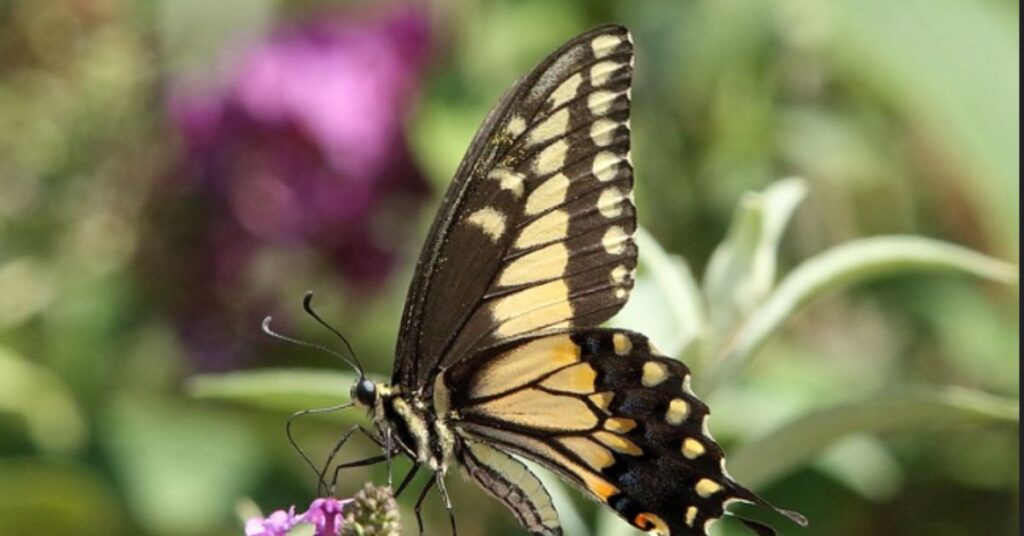
Size: The Anise Swallowtail has a wingspan of 2.5 to 3.5 inches.
Coloration and Wing Patterns: The black wings have a broad yellow stripe. There is a yellow-orange eyespot near the tail of the hindwing.
Identifying Features:The Anise Swallowtail is easily identified by its black wings with yellow markings. The yellow-orange eyespot on the hindwing is also a distinctive feature.
Unique Behaviors:The Anise Swallowtail has a few unique behaviors. One is that it will sometimes perch on hilltops and patrol for receptive females.
The female lays eggs singly on host plant leaves and flowers. Young caterpillars eat leaves, while older ones eat flowers. Chrysalids hibernate.
Here are some additional facts about the Anise Swallowtail Butterfly:
- It is a common butterfly in Oregon and can be found from April to July.
- Its caterpillars feed on various plants in the parsley family, including Queen Anne’s lace, fennel, and lovage.
- The Anise Swallowtail is a pollinator that helps spread the seeds of its host plants.
#8. Lorquin’s Admiral Butterfly (Limenitis lorquinii)
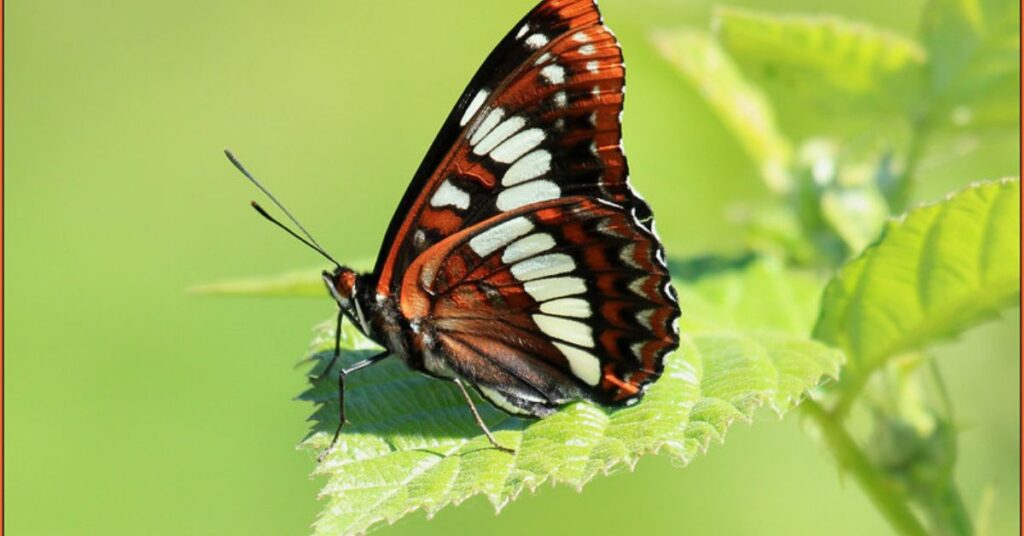
Size: The Lorquin’s Admiral has a wingspan of 2 to 2.5 inches.
Coloration and Wing Patterns: The wings are black with two white bands across them. The forewing has an orange-brown tip. The underside of the wings is a complex pattern of brown, blue, and orange.
Identifying Features:The Lorquin’s Admiral is easily identified by its black wings with white and orange markings. The orange-brown tip on the forewing is also a distinctive feature.
Unique Behaviors:The Lorquin’s Admiral has a few unique behaviors. One is that it will sometimes perch on rocks or logs and bask in the sun.
The female lays eggs singly on host plant leaves. Young caterpillars eat leaves, while older ones eat flowers. Chrysalids hibernate.
Here are some additional facts about the Lorquin’s Admiral Butterfly:
- It is a common butterfly in Oregon and can be found from April to October.
- Its caterpillars feed on various plants in the willow family, including wild cherry, willow, and poplar.
- The Lorquin’s Admiral is a pollinator and helps spread the seeds of its host plants.
#9. Acmon Blue Butterfly (Plebejus acmon)
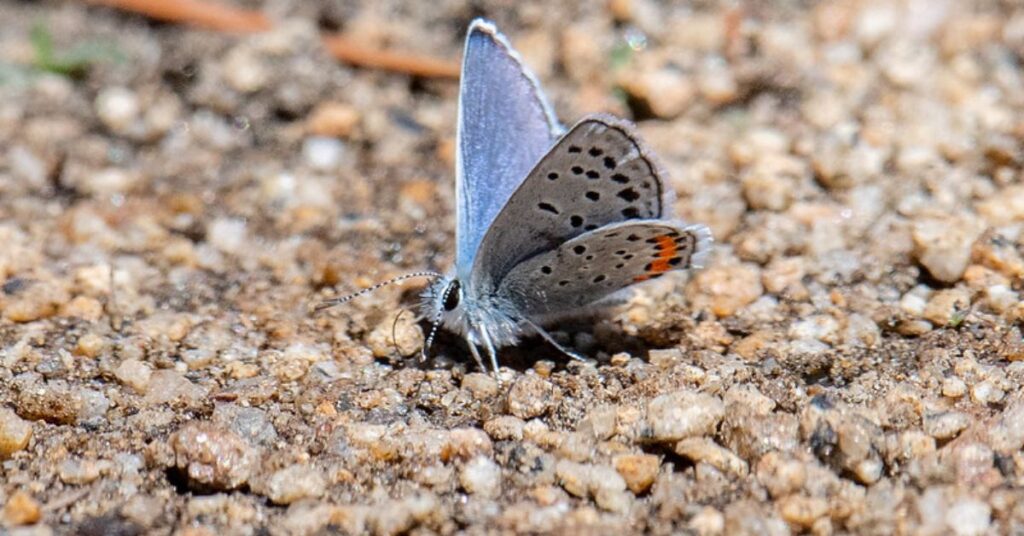
The Acmon Blue Butterfly (Plebejus acmon) is a captivating species found in Oregon. Size: It is modest, with a wingspan measuring 1 to 1.5 inches.
Coloration and Wing Patterns: The butterfly displays a beautiful coloration and wing pattern.
The upper side of the wings is predominantly blue with black borders, while the underside is grayish-brown with orange and white spots.
Identifying Features: The features of the Acmon Blue Butterfly include its small size, blue wings with black borders, and orange and white spots on the underside.
Unique Behaviors: Unique behaviors of this butterfly include its tendency to fly low to the ground and its preference for nectar on flowers.
#10. Sara Orangetip Butterfly (Anthocharis sara)
The Sara Orangetip Butterfly (Anthocharis sara) is a beautiful species found in Oregon.
Size: It is modest, typically measuring around 1.5 to 2 inches in wingspan.
Coloration and Wing Patterns: The butterfly showcases a striking coloration and wing pattern.
The upper side of the wings is predominantly white, with black wing tips and an orange patch on the males’ wings.
The females lack the orange patch but have black wing tips.
Identifying Features: Identifying features of the Sara Orangetip Butterfly include its size, white wings with black tips, and the presence or absence of the orange patch, depending on the gender.
Unique Behaviors: Unique behaviors of this butterfly include its swift flight and its preference for nectaring on early spring flowers.
- Delicate Butterflies with Subtle Beauty
• Oregon Silverspot Butterfly (Speyeria zerene)
• Great Spangled Fritillary Butterfly (Speyeria cybele)
• Clodius Parnassian Butterfly (Parnassius clodius)
• Pale Swallowtail Butterfly (Papilio jurymen)
• Propertius Duskywing Butterfly (Erynnis propertius)
#11 Oregon Silverspot Butterfly (Speyeria zerene)
The Oregon Silverspot Butterfly (Speyeria zerene) is a captivating species native to Oregon.
Size: It is moderate, with a wingspan measuring around 2.5 to 3 inches.
Coloration and Wing Patterns: The butterfly displays a stunning coloration and wing pattern.
The upper side of the wings is predominantly orange-brown with black veins and spots, while the underside is pale with silver spots.
Identifying Features: Identifying features of the Oregon Silverspot Butterfly include its size, orange-brown wings with black markings, and distinctive silver spots on the underside.
Unique Behaviors: Unique behaviors of this butterfly include its specialized habitat requirement.
It relies on coastal grasslands and meadows where its host plant, the early blue violet, grows.
The Oregon Silverspot Butterfly has a short flight season and exhibits territorial behaviour, defending its habitat patch.
This species holds ecological significance, highlighting the importance of preserving its unique coastal ecosystems in Oregon.
#12. Great Spangled Fritillary Butterfly (Speyeria cybele)
The Great Spangled Fritillary Butterfly (Speyeria cybele) is a captivating butterfly species in various regions, including Oregon.
Size: It showcases a notable size, with a wingspan measuring around 2.5 to 4 inches.
Coloration and Wing Patterns: The butterfly displays a stunning coloration and wing pattern.
The upper side of the wings is predominantly orange-brown with black markings, and it features prominent silver spots near the wing edges.
The underside of the wings is lighter, with a mix of brown, yellow, and silver markings.
Identifying Features: The Great Spangled Fritillary Butterfly’s features include its size, orange-brown wings with silver spots, and the distinct pattern on the underside.
Unique Behaviors: This species exhibits unique behaviors, such as engaging in a slow and leisurely flight, often gliding among meadows and flower-rich habitats.
It primarily feeds on nectar from various wildflowers, contributing to pollination.
#13. Clodius Parnassian Butterfly (Parnassius clodius)
The Clodius Parnassian Butterfly (Parnassius clodius) is an exquisite and notable butterfly species. This butterfly can be found in various regions, including Oregon.
Size: It boasts a substantial size, with a wingspan measuring around 2.5 to 3.5 inches.
Coloration and Wing Patterns: The Clodius Parnassian Butterfly displays a distinctive coloration and wing pattern.
The wings are primarily white, with black veins and markings. The upper side of the wings showcases a unique pattern with contrasting black and white. At the same time, the underside is predominantly white with delicate greyish markings.
Identifying Features: Features of the Clodius Parnassian Butterfly include its size, white wings with black markings, and characteristic patterns on both sides.
Unique Behaviors: This species exhibits unique behaviors such as slow and graceful flight, often fluttering near rocky or mountainous habitats.
It primarily feeds on flower nectar and is known for its preference for specific host plants.
The Clodius Parnassian Butterfly adds a touch of elegance and beauty to the natural landscapes of Oregon, captivating observers with its enchanting presence.
#14. Pale Swallowtail Butterfly (Papilio eurymedon)
The Pale Swallowtail Butterfly (Papilio eurymedon) is a captivating species in various regions, including Oregon.
Size: It boasts a substantial size, with a wingspan measuring around 3.5 to 4 inches.
Coloration and Wing Patterns: The butterfly exhibits a striking coloration and wing pattern.
The wings are predominantly white with black veins and markings. The upper side of the wings showcases a unique pattern with contrasting black and white. At the same time, the underside is predominantly pale with intricate greyish markings.
Identifying Features: The features of the Pale Swallowtail Butterfly include its size, white wings with black markings, and characteristic patterns on both sides.
Unique Behaviors: This species is known for its graceful flight and preference for nectar-rich flowers.
The Pale Swallowtail Butterfly adds a touch of elegance and beauty to the natural landscapes of Oregon, captivating observers with its enchanting presence.
#15. Propertius Duskywing Butterfly (Erynnis propertius)
The Propertius Duskywing Butterfly (Erynnis propertius) is a fascinating species in various regions, including Oregon.
Size: It is a medium-sized butterfly with a wingspan measuring approximately 1.5 to 2 inches.
Coloration and Wing Patterns: The butterfly exhibits a distinctive coloration and wing pattern.
The upper side of the wings is dark brown with subtle orange markings near the tips, while the underside is lighter with a mix of brown and greyish tones.
Identifying Features: Identifying features of the Propertius Duskywing Butterfly include its size, dark brown wings with orange markings, and the subtle chevron-shaped pattern on the forewings.
Unique Behaviors: This species is known for its swift flight and its preference for open grassy areas and woodland edges.
It is often seen flying low to the ground, darting between vegetation and flowers.
- Butterflies with Camouflage in Oregon
• Western Tailed-Blue Butterfly (Cupido amyntula)
• California Tortoiseshell Butterfly (Nymphalis californica)
• Common Ringlet Butterfly (Coenonympha tullia)
• Woodland Skipper Butterfly (Ochlodes sylvanoides)
• Silvery Blue Butterfly (Glaucopsyche lygdamus)
#16. Western Tailed-Blue Butterfly (Cupido amyntula)
Size: The Western Tailed-Blue Butterfly, scientifically known as Cupido amyntula, is a small-sized butterfly commonly found in Oregon. It belongs to the family Lycaenidae and is known for its petite stature.
Typically, the wingspan of the adult Western Tailed-Blue Butterfly ranges from 0.75 to 1 inch (1.9 to 2.5 cm).
Coloration and Wing Patterns: This butterfly species exhibits stunning coloration and intricate wing patterns.
The upper side of the male Western Tailed-Blue Butterfly’s wings is a vibrant blue, with a slight tinge of violet near the body.
On the other hand, the females have a more subdued grayish-blue coloration. Both genders feature a black border along the outer edges of their wings, complemented by a row of orange spots near the hindwing.
Identifying Features: The Western Tailed-Blue Butterfly possesses a few distinctive identifying features.
Besides its characteristic blue color, this species has a unique hindwing with a thin tail-like extension, giving it its name.
This tail is more prominent in males than females. Additionally, close observation reveals a series of small black spots on the undersides of both wings.
Unique Behaviors: One fascinating aspect of the Western Tailed-Blue Butterfly is its behavior.
These butterflies exhibit a “hilltopping” behavior, commonly gathering on the summits of hills or other elevated locations.
This behavior serves as a means for social interaction and potential mate selection. Interestingly, they also engage in territorial disputes, defending their chosen location from other males in pursuit of a mate.
#17. California Tortoiseshell Butterfly (Nymphalis californica)
Size: The California Tortoiseshell Butterfly, scientifically known as Nymphalis californica, is a medium-sized butterfly typically found in Oregon.
It has a wingspan ranging from 2.5 to 3 inches (6.4 to 7.6 cm), making it a moderately sized butterfly compared to others in its family.
Its wings are broad and rounded, enabling efficient flight and manoeuvrability.
Coloration and Wing Patterns:
The wings of the California Tortoiseshell Butterfly are a remarkable display of vibrant colors and intricate patterns.
The upper side of their wings features a vibrant orange hue, accented by dark brown borders and black spots.
The wing tips typically have a characteristic row of distinct blue spots, adding to their overall beauty.
When their wings are closed, the undersides reveal a unique mosaic pattern with shades of brown and beige, helping them blend into their natural surroundings.
Identifying Features: The California Tortoiseshell Butterfly possesses several identifying features that distinguish it from other butterfly species. Apart from its striking coloration and wing patterns, it can be recognized by the silver-white markings on the undersides of its hindwings.
These markings, combined with the blue spots on the upper side of the wings, make it relatively easy to identify the California Tortoiseshell Butterfly.
Unique Behaviors: One of the most intriguing characteristics of the California Tortoiseshell Butterfly is its migratory behavior.
During the summer months, vast numbers of these butterflies migrate northward from their winter hibernation sites in California to reach Oregon.
The search for better feeding opportunities and favorable weather conditions drives this migration.
Apart from migration, another fascinating behavior of the California Tortoiseshell Butterfly is its ability to enter a state of aestivation.
During drier and warmer periods, these butterflies can enter a dormant state, reducing their metabolic activities and seeking refuge in cooler and shaded areas.
This adaptation allows them to conserve energy and survive unfavorable environmental conditions until more suitable conditions prevail.
#18. Common Ringlet Butterfly (Coenonympha tullia)
Size: The Common Ringlet Butterfly, scientifically known as Coenonympha tullia, is a medium-sized butterfly found in Oregon, United States.
The wingspan of an adult Common Ringlet Butterfly ranges from 1.5 to 2.2 inches, with females typically being larger than males.
Coloration and Wing Patterns: The Common Ringlet Butterfly displays a unique coloration and wing pattern.
The upper side of its wings is usually dark brown, while the underside is lighter in color.
The wings are adorned with distinct black and dull orange spots, contributing to its camouflage.
Identifying Features: Several features help distinguish the Common Ringlet Butterfly from other butterfly species.
Apart from its dark brown wings with unique black and dull orange spots, it has prominent eyespots near its wing margins.
These eyespots serve as a defence mechanism, as they can deter potential predators.
Unique Behaviors: The Common Ringlet Butterfly exhibits fascinating behaviors that set it apart from other butterfly species.
One distinct behaviour is a preference for shaded areas and cooler habitats. It is commonly found in wooded areas, stream banks, and moist meadows. Unlike many other butterfly species, the Common Ringlet Butterfly is most active during cloudy and overcast days, as it avoids direct sunlight.
#19. Woodland Skipper Butterfly (Ochlodes sylvanoides)
Size:
The Woodland Skipper Butterfly, scientifically known as Ochlodes sylvanoides, is a small to medium-sized butterfly found in Oregon.
The average wingspan of this butterfly ranges from 1 to 1.5 inches. Despite its small size, the Woodland Skipper Butterfly is known for its vibrant colors and distinctive wing patterns.
Coloration and Wing Patterns:
The Woodland Skipper Butterfly displays a combination of brown, orange, and yellow hues in its coloration.
The upper side of its wings is predominantly brown, with patches of orange and yellow creating a beautiful contrast.
The underside of its wings is lighter in color, featuring a subtle pattern of spots and lines.
Identifying Features:
One of the distinctive features of the Woodland Skipper Butterfly is its short, stout body.
This butterfly species has relatively broad wings compared to its body size. It also possesses large compound eyes and long, thin antennae. The Woodland Skipper Butterfly showcases a fluttering, erratic pattern when in flight.
Unique Behaviors:
The Woodland Skipper Butterfly exhibits a fascinating behavior called “hilltopping.” This behavior refers to their tendency to gather and perch on the highest points of hills or ridges.
These gathering spots serve as meeting places and hunting grounds for both male and female butterflies. Hilltopping is considered a crucial part of their mating rituals.
Apart from hilltopping, the Woodland Skipper Butterfly is known for its quick flight and agility.
It can dart in and out of vegetation with remarkable speed, making it challenging to spot or capture.
#20. Silvery Blue Butterfly (Glaucopsyche lygdamus)
Size: The Silvery Blue Butterfly is relatively small in size.
On average, it measures about 1 to 1.3 inches (2.5 to 3.3 cm) in wingspan.
Females of this species are usually slightly larger than males.
Coloration and Wing Patterns:
The upper side of the wings in males is a vibrant blue color.
Conversely, females display a range of hues from pale blue-gray to darker shades of brown.
Both males and females possess a thin black border along the wing edges.
The undersides of the wings are a pale grey colour, with prominent black spots and a sprinkling of orange scales near the edges.
These distinct coloration and wing patterns aid in distinguishing the Silvery Blue Butterfly from other species.
Identifying Features:
Its primary identifying features are the Silvery Blue Butterfly’s small size and overall blue coloration.
Males have a more intense and widespread blue coloration compared to females.
The presence of black borders along the wing edges is another distinguishing characteristic.
The orange scales on the undersides of the wings, particularly near the edges, are unique to this species.
Unique Behaviors:
The Silvery Blue Butterfly exhibits fascinating behaviors that set it apart from other butterflies.
This species strongly prefers open grasslands, meadows, and other sunny habitats.
They often fluttered around low-growing flowering plants, such as lupines and vetches, as they feed on nectar.
Silvery Blue Butterflies engage in a behavior known as “hilltopping,” where males congregate atop elevated locations to search for females.
Females lay their eggs on the undersides of host plants, which serve as a crucial food source for their caterpillars.
The caterpillars of the Silvery Blue Butterfly have a mutualistic relationship with ants. They secrete a sweet substance that ants feed on, in return for protection from predators.
#21. Greenish Blue (Plebejus saepiolus):
The Greenish Blue typically has an average wingspan of 1.2 to 1.6 inches (3 to 4 cm) and a body size of around 0.8 inches (2 cm).
It is important to note that there may be slight variations in size among individuals. Additionally, there may be differences between males and females, with males generally being smaller than females.
Coloration and Wing Patterns
The Greenish Blue gets its name from the predominant coloration observed on its wings.
The upper side of its wings displays a stunning greenish-blue hue with a metallic sheen, which varies in intensity among individuals.
The wings also often feature dark-bordered patches and spots, lending a unique pattern that distinguishes it from other species.
Identifying Features
To identify a Greenish Blue, paying attention to specific features is crucial. One characteristic is a distinct orange spot near the center of the underside of the hindwing.
This spot is a crucial distinguishing feature and helps separate it from other species with similar coloration.
Additionally, the presence of black-edged forewing spots may also aid in identification.
Unique Behaviors
The Greenish Blue exhibits fascinating behaviors that make it stand out among other butterflies.
Regarding feeding, it often visits a wide range of flowers, displaying a preference for certain nectar sources. This butterfly also goes sunbathing, where it perches with open wings facing the sun, utilizing the warmth for various purposes, including regulating body temperature.
#22. Great Basin Wood-Nymph (Cercyonis sthenele):
Size:
The Great Basin Wood-Nymph (Cercyonis sthenele) is a medium-sized butterfly found in Oregon. With an average wingspan of 2 to 2.5 inches, it falls within the range of other common butterflies in the region.
Coloration and Wing Patterns:
The Great Basin Wood-Nymph exhibits beautiful and distinct coloration. Its wings are predominantly brown, with variations in shades ranging from light to dark.
The upper side of the wings showcases multiple eyespots, which are bold and prominent in contrasting colors, including orange, black, and white.
This striking pattern aids in its recognition and differentiation from other species.
Identifying Features:
One can focus on its unique features to identify the Great Basin Wood-Nymph. Apart from its size and coloration, the butterfly has several distinguishing characteristics.
The upper side of the wings displays a row of eyespots near the outer margins, which are particularly large and noticeable.
The wings may also have faint bands or markings that further aid in identification.
Unique Behaviors:
The Great Basin Wood-Nymph exhibits intriguing behaviors that distinguish it from other butterfly species. One notable behavior is its preference for specific habitat types.
This butterfly is typically found in open areas, including meadows, grasslands, and sagebrush steppe environments.
It tends to frequent areas abundant with its preferred nectar sources, such as wildflowers and flowering shrubs.
After Thought On 22 Common Oregon Butterflies: Pictures with Identifying Features
The world of Oregon butterflies is enchanting, with its diverse species and delicate beauty. Understanding and appreciating the unique identifying features of Oregon butterflies is crucial in recognizing their significance in Oregon’s ecosystem and supporting their conservation efforts.
By protecting their habitats and appreciating their fragile existence, we can ensure the long-term survival of these remarkable creatures and continue to marvel at their captivating presence.
